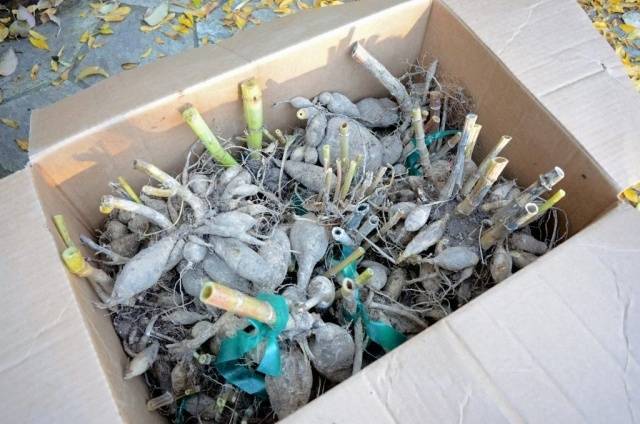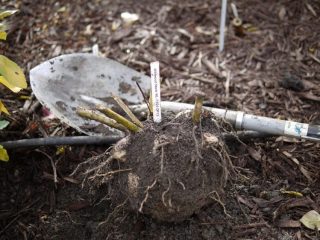Content
The luxury and splendor of dahlias deserve the love of many gardeners and summer residents. Even the most modest area will be more colorful if you plant dahlias on it. Therefore, it is not strange that many summer residents and gardeners have these flowering plants of various varieties in their arsenal.
However, the joy from the flowering of dahlias will be short-lived if you do not provide the necessary conditions for winter storage of tubers in your house or apartment. From this article you will learn how to preserve dahlias in your apartment until spring.
How and when to dig up dahlias
There are ground rules storage of dahlia tubers, but much of your success depends on when and how you dig up the roots of these plants. To ensure early flowering of dahlias, you need to start working on them at the end of February.
The optimal time for digging up tubers is the first autumn frost. Do not delay this, as otherwise the frost will destroy the shoots, which will soon begin to rot during storage and spread to the planting material. As a result, all preparations for planting may perish.
It is also not worth digging up the tubers too early, as they are also poorly stored.In addition, in this situation, you should not expect abundant flowering next season. This is due to the fact that green leaves provide natural nutrition to the root system, while the buds are actively preparing for the next flowering.
So, before digging up the plants, you should trim the stems. This way, you definitely won’t damage the roots or buds. To avoid damaging the root collar, you need to leave stumps about 20 cm high above the ground. In addition, in order not to damage the dahlia neck, you must place the shovel not too close to the stems, and you should not pull the bush by the stems.
To safely dig up planting material, you should dig up the bush on all sides at a distance of about 30 cm from the stems, then rake away the soil and remove the roots. But that is not all. Tubers need to be prepared for storage.
The secret to successful storage lies in the quality preparation of the bulbs for wintering. So, a number of preparatory operations should be carried out:
- Flushing. The roots should be shaken off the ground and washed in running water.
- Shortening. Using sharp scissors, cut off the shoots from the tubers by about 15 cm.
- Division. At this stage you need to divide the rhizomes. The stems are cut almost to the base of the tubers. There should be buds on each root. Solid roots with underdeveloped buds do not need to be separated.
- Disinfection. To disinfect planting material, you need to immerse it in a solution of potassium permanganate for half an hour. This event minimizes the possibility of the development of fungal diseases and rotting of tubers. Another disinfection option is to treat the rhizomes with a fungicide. Each cutting should be checked for signs of disease and damage. All roots with suspicious spots should be destroyed.White plaque on tubers is a sign of the initial stage of fungal infection. Such roots must be destroyed immediately, otherwise all planting material will die before spring.
- Drying. The roots must be thoroughly dried in fresh air after washing.
Methods for storing tubers
Gardeners have come up with many ways to store dahlia tubers. The simplest and most common method is to store dahlias in boxes lined with newspaper. However, this method is not always suitable. As an option, you can store dahlias in an apartment in a clay or paraffin shell, as well as in plastic film. Each of these storage methods will be described further in the article.
In boxes
If we talk about storing dahlia planting material in boxes, then they must be wooden. The bottom is covered with newspaper, and then tubers are placed in boxes for winter storage of plants. They need to be covered with newspaper and put in the basement or other place where you usually store vegetables.
Also, for better preservation, some summer residents fill the boxes with tubers with sand or sawdust. But, if you have to store planting material in the winter in an apartment, then this option will not suit you.
Waxing of planting material
To make it easier to store dahlias in an apartment, gardeners have come up with another method, which involves waxing the tubers. To do this, you need to purchase regular candles or special paraffin and boxes/nets for storing planting material. Then the paraffin is heated in a steam bath over medium heat.Afterwards, you need to dip the pre-washed, dried and disinfected tubers on both sides into molten paraffin.
Paraffinized dahlia tubers are placed in boxes according to variety, and then sent for storage on the balcony or in the pantry. The storage location should be cool and with low humidity. Before planting tubers in the spring, you need to clean the planting material from paraffin by carefully wiping it with a dry cloth.
Storage in polyethylene
It takes less time to prepare for storing tubers in plastic bags or cling film. In addition, this method of storing tubers is cheaper. Before packaging planting material, it must be treated with colloidal sulfur. Peat is poured into the bag and the tuber is placed, and then the bag is tied tightly.
The packaged planting material is placed in boxes and placed in a cool, dark place. The main advantage of the storage method is the absence of contact between the tubers, which makes it impossible for one root to become infected from another. The condition of each spine can be easily checked by simply untying the bag. The same manipulations should be carried out when twisting the roots into cling film.
Clay shell
One way to store dahlias in low humidity conditions is to use a clay shell. To do this, dilute the clay in water to a creamy consistency. Then you should dip the tubers in the diluted solution and place them in a cool, dark place to dry. When a clay crust forms on the tubers, they can be transferred to a storage box. In spring, you need to free the tubers from the shell.To do this, you need to lightly tap on them and the clay shell will crumble.
Conclusion
So, storing dahlia tubers is not so difficult. By following the above recommendations, you can avoid rotting and fungal infection of planting material. For more information, we recommend that you also watch the accompanying video:
















